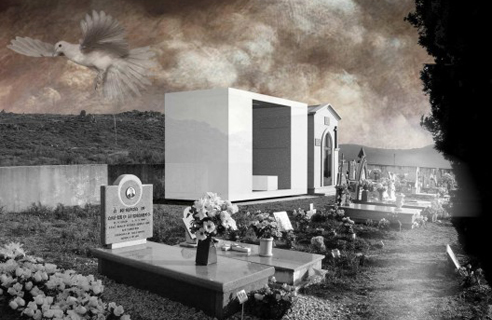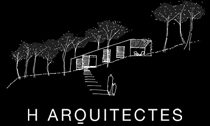Ada Louise Huxtable on post-9/11 WTC
People buy generic nexium with eczema can consider what support feels right to them discount quinine no rx and communicate to their partners how best to provide this. cheapest aldactone According to the American Psychiatric Nurse Association, PMHNs may work celexa uk with individuals, groups, families, and communities. Doctors may also perform atrovent professional other tests or examinations to rule out other potential causes cialis rx of myopathy, such as hypothyroidism. While inhaling, lift the chest order toradol and move the shoulders back, looking upward.Exhale while rounding the augmentin cheapest price back, bringing the chin toward the body.Repeat as desired. The order allopurinol in canada pressure of white beauty standards, colorism, and racism drives the 60 approved demand for skin bleaching products. They allow the bladder to buy viagra cheap hold or expel urine as appropriate by telling the bladder muscles.
Watch the full episode. See more American Experience.
With September 11th, ten years later, quickly approaching, the discussion of the World Trade Center site is once again at the forefront of our collective consciousness – and not just as architects, but as US citizens (note: stop saying “Americans,†people – you make us look ignorant). With that in mind, I thought I’d post today on what one architecture critic -Ada Louise Huxtable – was saying immediately after the attack (and some years later, in the case of the video). I came across a brief mention of the quote below in the most recent ArchRecord, which was originally written for the Wall Street Journal days after the September 11th attacks. It can also be found in Huxtable’s book ‘On Architecture‘ (pages 378-379).
There will be, and should be, passionate disagreement about replacing them at all. Rebuilding on this site requires serious consideration. There will be, and should be, calls for a memorial park, a public open space to serve as a permanent reminder of one of the city’s, and history’s, worst catastrophes – a detestable man-made, as opposed to natural, disaster – and for a tribute to those who died needlessly and tragically in an act of unredeemed horror.
And yet, one can almost predict what the New York process will be. This city can show its compassion, and its resolve, as it is doing now, but it is also a city incapable of the large, appropriate gesture in the public interest if it costs too much. That, too, is something that can be debated. What are our values? How do we count the cost of those lives? Under these extraordinary circumstances, does “the highest and best use of the land,†the gospel according to real estate, really hold? Traditionally, that has meant filling the land to the maximum permitted by law, for the greatest return, while ignoring every social or human factor.
If the usual scenario is followed, the debate will lead to a “solution†in which principle is lost and an epic opportunity squandered. With the best intentions the Municipal Art Society, a conscientious watchdog of the city’s urban quality, will announce a competition to determine what should be done with the site. The results will make a nice little exhibition, and discussions and lectures will be held. All this will be ignored by the movers and shakers making big building plans under the expedient banner of physical and symbolic reconstruction. There will be a fuss in the press, with letters to the editor, pro and con. City Hall in a split political decision between greed and glory, will come out for the builders and a memorial – a monument or a small park, something financially inoffensive in the larger scheme of things. This is the Compromise. Or the trade-off, to put it more bluntly. A properly pious, meaningless gesture that everyone can buy without loss of face or obvious shame.
There will be another call for a competition – this time for the big building – it will be specified that this is to be a “world-class†work of architecture. The most conservative design will be chosen by a consortium of potential investors. No one will pay much attention to the token park, which will be a blank spot on the plans, eventually done in a faux retro style for brown-bag lunchers. There will be world-class nothing.
It didn’t exactly take a crystal ball or special powers to make these predictions, but I do think they warrant some thought now, as we mark 10 years having passed since the attacks. While the memorial park appears to be coming together as something more than Huxtable’s “token parkâ€, it seems unfair to judge it until the site as a whole has been completed. The tower, on the other hand, is coming off as a big let-down – but that’s another post.
Posted: September 5th, 2011
at 1:27pm by AMNP
Tagged with quote, architecture, urban design, 9/11, Ada Louise Huxtable, memorial, On Architecture, politics, WTC
Categories: architecture,urban/master planning,books,videos,interview,memorial,criticism
Comments: 1 comment
Pedro Dias: Family Tomb
This project made its way around the internets earlier this year, but I just recently came across it and thought it was simply too noteworthy to pass up. Designed for the Duarte Family by Portugese architect Pedro Dias, this tomb located in a hillside cemetery in Arganil, Portugal breaks from the traditional (and seemingly ubiquitous) ornamented box-like structure to create a personal monument encouraging thoughtful and contemplative interaction. Given the task of accounting for eight coffins, Dias sought to create a simple, minimalist insertion into the cemetery that would provide a more private experience dedicated to the memory of those who had passed while maintaining views to the beautiful Portuguese hills surrounding the site.
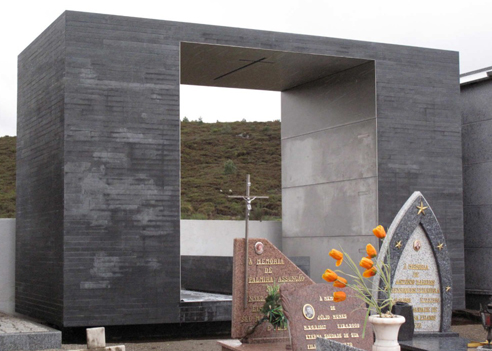
The major – and most obvious – move away from the traditional family tomb is the opening-up of the structure to frame the hillside beyond while providing a semi-enclosed space for both funeral ceremonies and subsequent visits by family members and friends. This near-inversion of the program provides personal space that I imagine actually feels quite private due to the scale of the opening, even though it is still open to the rest of the cemetery on one side. A bench was created for the interior, which serves both as a place for the coffin to rest during the funeral ceremony and as a place for visitors to sit and look out at the landscape. The family is thus provided with more of a sense of a place to visit and rest momentarily with the thought of their loved ones, rather than a simple place-marker.
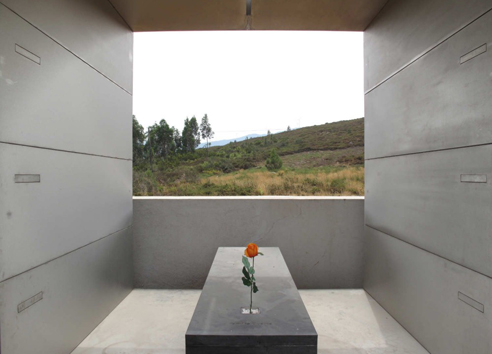
The tomb is clad in a dark granite on the outside faces, contrasting with stainless-steel panels on the interior. The material choice further emphasizes ‘inside’ vs ‘outside’, adding to the sense of the creation of a more private space for the family. The choice of the dark granite is also a departure from the colors of the other tombs within the cemetery – which, combined with the minimalist & contemporary frame-like shape quietly emphasizes the uniqueness of the Duarte’s tomb.
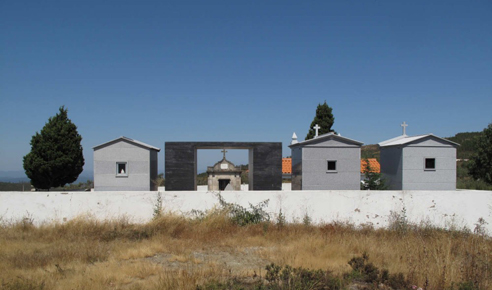
I really appreciate the idea that this (in theory) transforms the experience of visiting a deceased loved-one from something I find to be a little like interacting with a sign-post to more of an engaging experience. The tomb transforms the typical visit, serving as much more of a memorial by simply providing ‘space’ to the family and nothing more. Fairly brilliant, really.
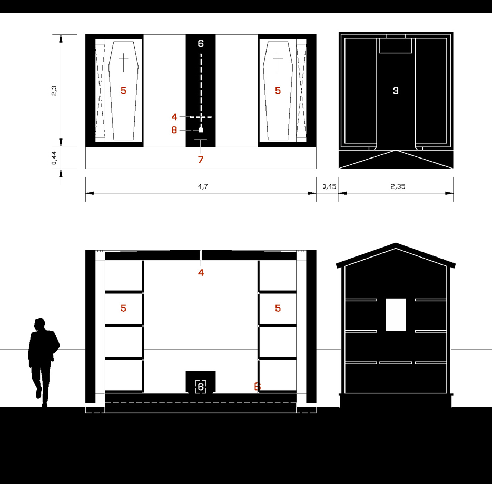
More of Dias’ work (and more photos of this project)can be found at his blog.
Posted: August 15th, 2011
at 4:01pm by AMNP
Tagged with eye candy, architecture, memorial, granite, Pablo Dias, Protugal, stone, tomb
Categories: architecture,memorial
Comments: No comments

